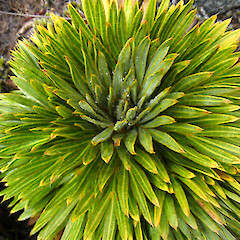Aciphylla crosby-smithii
Family
Apiaceae
Flora category
Vascular – Native
Endemic taxon
Yes
Endemic genus
No
Endemic family
No
Structural class
Herbs - Dicotyledons other than Composites
NVS code
The National Vegetation Survey (NVS) Databank is a physical archive and electronic databank containing records of over 94,000 vegetation survey plots - including data from over 19,000 permanent plots. NVS maintains a standard set of species code abbreviations that correspond to standard scientific plant names from the Ngä Tipu o Aotearoa - New Zealand Plants database.
ACICRO
Current conservation status
The conservation status of all known New Zealand vascular plant taxa at the rank of species and below were reassessed in 2017 using the New Zealand Threat Classification System (NZTCS) – more information about this can be found on the NZTCS website. This report includes a statistical summary and brief notes on changes since 2012 and replaces all previous NZTCS lists for vascular plants.
Please note, threat classifications are often suggested by authors when publications fall between NZTCS assessment periods – an interim threat classification status has not been assessed by the NZTCS panel.
- Conservation status of New Zealand indigenous vascular plants, 2017 . 2018. Peter J. de Lange, Jeremy R. Rolfe, John W. Barkla, Shannel P. Courtney, Paul D. Champion, Leon R. Perrie, Sarah M. Beadel, Kerry A. Ford, Ilse Breitwieser, Ines Schönberger, Rowan Hindmarsh-Walls, Peter B. Heenan and Kate Ladley. Department of Conservation. Source: NZTCS and licensed by DOC for reuse under the Creative Commons Attribution 4.0 International licence.
2017 | At Risk – Naturally Uncommon | Qualifiers: DP, RR, Sp
Previous conservation statuses
2012 | At Risk – Naturally Uncommon | Qualifiers: RR
2009 | At Risk – Naturally Uncommon
2004 | Range Restricted
Brief description
Robust elongate tufts of broad spiky leaves with white flowers in a ball on a long fleshy stalk in southern Fiordland
Distribution
Endemic. South Island; southern Fiordland (possibly also in western Otago and elsewhere in Fiordland)
Habitat
Exposed rocky slopes and short snow tussock herbfield. 1400-1600 m a.s.l.
Detailed description
Herb forming stout tufts to 40 cm tall in flower. Rosettes several, crowded, +/- elongate, forming cushionlike mass to 60 cm diam. Leaves many, extending along base of flowering stem, stiff, 1-pinnate; sheath broad, membranous, 4 cm long x 1.5 cm wide, slowly narrowing to apex; stipules similar to pinnae, 35 mm long x 5 mm wide, narrowing to small mucro; leaf with pinnae in 2-3 pairs, petiole and internode (inter-pinnae spacing) short, linear-oblong, c. 3 cm long x 3-4 mm wide, midrib often red, margin slightly thickened, yellow, tapering to pungent mucro. Flowering stem grooved, c. 25 cm long x (2-)4-5 cm wide, upper nude part slender, lower part sheathed by leaves. Inflorescence a globose head of compound umbels; involucral bracts with thick sheaths up to 2 cm long and leaflike stipules and lamina. Primary umbels usually several, c. 2.5 cm diam., secondary umbels on almost filiform rays. Fruit of two mericarps; mericarps narrowly-elliptic to elliptic, 4.0-5.2 mm, with 5 even narrowly winged ribs, 4 smaller ribs on vittae, vittae largely obscured
Similar taxa
Most similar to A. spedenii and A. congesta, but the leaves extending along the basal portion of the flowering stem is distinctive
Flower colours
Cream, White
Life cycle
Winged schizocarps are dispersed primarily by wind (Thorsen et al., 2009).
Etymology
aciphylla: From the Latin acicula ‘needle’ and the Greek phyllum ‘leaf’, meaning needle-leaf.
Attribution
Description adapted from Allan (1961), Mark and Adams (1995), Webb and Simpson (2001) and Wilson (1996).
References and further reading
Allan, H.H. 1961. Flora of New Zealand. Government Printer, Wellington
Mark, A.F; Adams, N.M. 1995. New Zealand alpine plants, 2nd Edition. Godwit Publishing, Auckland
Thorsen, M. J.; Dickinson, K. J. M.; Seddon, P. J. 2009. Seed dispersal systems in the New Zealand flora. Perspectives in Plant Ecology, Evolution and Systematics 2009 Vol. 11 No. 4 pp. 285-309
Webb, C.J. & Simpson, M.J.A. 2001. Seeds of NZ gymnosperms and dicotyledons. Manuka Press, Christchurch











